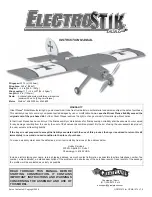
15
Balance Propellers
Carefully balance your spare propellers before you fl y. An
unbalanced prop can be the single most signifi cant cause
of vibration that can damage your model. Not only will motor
mounting screws and bolts loosen, possibly with disastrous
effect, but vibration may also damage your radio receiver and
battery. We use a Top Flite Precision Magnetic Prop Balancer
(TOPQ5700) in the workshop and keep a Great Planes
Fingertip Prop Balancer (GPMQ5000) in our fl ight box.
Ground Check
Before the fi rst fl ight, inspect the model closely to make sure
all screws remained tight, the hinges are secure, the prop is
secure, and all pushrods and connectors are secure.
Range Check
Ground check the operational range of your radio before the
fi rst fl ight of the day. With the transmitter antenna collapsed
and the receiver and transmitter “ON”, you should be able to
walk at least 30m [100'] away from the model and still have
control. Have an assistant stand by your model and while
you work the controls, tell you what the control surfaces are
doing. Repeat this test with the motor running at various
speeds with an assistant holding the model, using hand
signals to show you what is happening. If the control surfaces
do not respond correctly, do not fl y! Find and correct the
problem fi rst. Look for loose servo connections or broken
wires, corroded wires on old servo connectors, poor solder
joints in your battery pack or a defective cell, or a damaged
receiver crystal from a previous crash.
MOTOR & BATTERY SAFETY PRECAUTIONS
Failure to follow these safety precautions may result in
severe injury to yourself and others.
Always leave the batteries unplugged unless you are
preparing to fl y. Assume that whenever the batteries are
plugged in, the motor and propeller could start at any time.
Stay away from the propeller when the motor batteries are
plugged in. NEVER have the motor batteries plugged in with
the radio system “OFF”.
Run the motor outside only and never run the motor in an
area of loose gravel or sand; the propeller may throw such
material in your face or eyes.
Keep these items away from the prop: loose clothing, shirt
sleeves, ties, scarves, long hair or loose objects such as
pencils, or screwdrivers that may fall out of shirt or jacket
pockets into the prop.
When turning off the system, always disconnect the motor
batteries fi rst and then turn the transmitter “OFF”.
Once the motor is “armed” always remain behind the arc of
the propeller until the batteries are disconnected.
Use safety glasses when running the motor.
Keep your face and body as well as all spectators away from
the plane of rotation of the propeller as you run the motor.
PROPER CARE OF YOUR MOTOR
Using multiple battery packs to run the motor for successive
fl ights may cause the motor to become excessively hot. We
recommend at least a 10-minute motor cool-down period
between fl ights.
LITHIUM BATTERY HANDLING & USAGE
WARNING!! Read the entire instruction sheet included
with your battery. Failure to follow all instructions
could cause permanent damage to the battery and its
surroundings, and cause bodily harm!
• ONLY use a LiPo approved charger. NEVER use a NiCd/
NiMH peak charger!
• NEVER charge in excess of 4.20V per cell.
• ONLY charge through the “charge” or “balance” lead.
NEVER charge through the “discharge” lead.
• NEVER charge at currents greater than 1C.
• ALWAYS set charger’s output volts to match battery volts.
• ALWAYS charge in a fi reproof location.
• NEVER trickle charge.
• NEVER allow the battery temperature to exceed 150° F
[65° C].
• NEVER disassemble or modify pack wiring in any way or
puncture cells.






































